前统治家族首领列表
維基媒體列表條目 来自维基百科,自由的百科全书
現有王位覬覦者列表是一個理論上有權「宣稱」或「想要」擁有王位的人物列表。值得注意的是:其中有的王位繼承者(或其王室成員後代)儘管實際上並沒有正式宣稱或已放棄繼承權,但按照過去法律「理論上」依然被視為可能繼任者。
此條目翻譯品質不佳。 |
非洲
| 國家 | 覬覦者 | 自從 | 王室 | 皇家徽章 | 依據 | 繼承性 | 廢除 | 文獻 |
|---|---|---|---|---|---|---|---|---|
| Rose Paula Iribagiza [af 1] | 1977年5月1日 | Ntwero | 
|
姆瓦姆布扎四世國王 (1915–1966)的女兒。 | 世襲制 | 1966 | [1][2] | |
| 博卡薩二世 | 1996年11月3日 | 博卡薩 | 
|
博卡薩一世皇帝(1976–1979)的繼承者。[af 2] | 世襲制 | 1979 | [3] | |
| 福阿德二世 | 1953年6月18日[af 3] | 穆罕默德·阿里 | 
|
最後在位的國王 (1952–1953)。 | 世襲制 | 1953 | [4] | |
| 札拉·雅各布·阿姆哈·塞拉西 [af 4] | 1997年2月7日 | 所羅門[af 5] | 
|
海尔·塞拉西一世皇帝 (1930–1974)之孫。 | 世襲制[af 6] | 1975 | [5][6] | |
| 吉爾馬·約翰尼斯·伊亞蘇 [af 7] | 1977年 | 伊亞蘇五世皇帝 (1913–1916)之孫。 [af 8] | ||||||
| Yves Ñzînga Mvêmb'a | 1962年10月 | Kilukeni[af 9] | 
|
Manikongo Afonso I (1509–1542)的後裔。 | 選舉及世襲制[af 10] | 1914 | [12][13] | |
| 穆罕默德·本·哈桑 | 1992年6月18日 | 塞努西 | 
|
Hasan ar-Rida 之子,伊德里斯一世國王(1916–1969)的繼承者。 | 世襲制 | 1969 | [14] | |
| 伊德里斯·本·阿卜杜勒 | 1989年5月 | 伊德里斯一世國王(1916–1969)的親戚。 | [15] | |||||
| 艾曼紐·布夏亞,尤西六世 | 2017年1月9日[af 11] | Ndahindurwa[af 12] | 
|
最後在位的國王吉利五世(1959–1961)的侄子。 | 世襲及選舉制[af 13] | 1962 | [18][20] | |
| 穆罕默德六世 | 2006年10月 | 阿爾·海珊 | 
|
Muhammad V an-Nasir 貝伊(1906–1922)之孫。 | 世襲制 | 1956 | [21] | |
| 賈姆希德·本·阿卜杜勒 | 1964年1月12日[af 14] | Al Bu Sa'id | 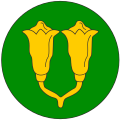
|
最後在位蘇丹 (1963–1964). | 世襲制 | 1964 | [22] |
美洲
| 國家 | 覬覦者 | 自從 | 王室 | 皇家徽章 | 主張 | 繼承性 | 廢除 | 文獻 |
|---|---|---|---|---|---|---|---|---|
| 貝特朗 | 2022年7月15日 | 奧爾良-布拉干薩[am 1] |  |
佩德羅二世皇帝 (1831–1889)的後裔。 | 世襲制 | 1889 | [25][26] | |
| 馬克西米利安·馮·格岑-伊圖爾維德 | 1949年12月 | 哈布斯堡-伊圖爾維德[am 2] |  |
阿古斯汀一世皇帝 (1822–1823)的後裔。 | 世襲制 | 1867 | [29] | |
| 諾頓·卡斯伯特·克拉倫斯 | 1977年 | 米斯基托家族 |  |
羅伯·特亨利·克拉倫斯酋長 (1890–1894)的後裔。 | 世襲及選舉制[am 3] | 1894 | [30] | |
| 利桑德罗·门德斯 | 2002年 | Blu | Bribri族人的巫師,且為 Awak種姓的成員(宗教)。 | 母系制度 Blu 族(君主種性)的後裔現已滅絕。 | 1920 | [31][32] | ||
| 菲利普一世 | 1952年10月26日 | 奥雷利耶 |  |
奥雷利耶-安托万·德·图龙的親屬,但非直系後裔。 | 世襲制 | 1862 |
亞洲
| 國家 | 覬覦者王号 | 自從 | 王室 | 皇家徽章 | 主張 | 繼承性 | 廢除 | 文獻 |
|---|---|---|---|---|---|---|---|---|
| Andrew Nikititch Shervashidze | 2008年7月17日 | Shervashidze |  |
米哈伊爾親王 (1823–1864)的後裔。 | 世襲制 | 1864 | ||
(王國) |
艾哈迈德沙王储 | 2007年7月23日 | 巴拉克宰 |  |
查希爾沙國王 (1933–1973)的繼承者。 [as 1] | 世襲制 | 1973 | [33] |
| 都·披耶泰 | 1948年4月12日 | 贡榜[as 2] |  |
錫袍國王(1878–1885)的後裔。 | 世襲制 | 1885 | [34] | |
| 其奧·納·占巴塞 | 1980年3月17日 | 占巴塞[as 3] | 文翁·納·占巴塞親王 (1945–1946)之子,最後在位親王。 | 世襲制 | 1946 | [35] | ||
| 大衛·巴格拉季昂 | 2008年1月16日 | 穆赫拉尼[as 4] |  |
康斯坦丁二世國王 (1478–1505)的後裔。 | 世襲制 | 1801 | [36][37] | |
| 努格扎爾·巴格拉季昂 | 1984年8月13日 | Gruzinsky[as 4] |  |
吉奧爾基十二世國王 (1798–1800)的後裔。 | ||||
| Sao Oo Kya [as 6] | 撣族 | Sao Kya Seng 詔法(1947–1962)的親戚。 | 世襲制 | 1962 | [38] | |||
(巴列維) |
禮薩二世 | 1980年7月27日 | 巴列維 | 穆罕默德·禮薩沙王 (1941–1979)的繼承者。 [as 7] | 世襲制 | 1979 | [39] | |
(卡扎爾) |
穆罕默德·哈桑·米爾扎二世 | 1988年5月5日 | 卡扎爾 |  |
穆罕默德·阿里沙王 (1907–1909)的後裔。 | 世襲制 | 1925 | [40] |
| 拉阿德·本·赛义德 | 1970年10月18日 | 哈希姆[as 8] |  |
費薩爾二世國王 (1939–1958)的親戚。 [as 9] | 世襲制 | 1958 | [42] | |
| Remigius Kanagarajah | Aryacakravarti | Cekaracacekaran IX 國王 (1617–1619)的後裔。 | 世襲制 | 1619 | [43] | |||
| 足利浩平 足利義弘 |
1983年11月2日 2003年 |
足利將軍家(國王) |  |
旁系足利基氏後裔。 旁系足利義維後裔。 |
世襲制 | 1573 | ||
| 德川家廣 | 2023年1月29日 | 德川將軍家(大君) |  |
水戶德川家初代當主德川賴房暨會津松平家當主松平容保的後裔。 | 世襲制 | 1867 | ||
| 卡洛八世 | 2008年3月20日 | 卡佩-波旁 |  |
亨利二世國王的親戚 | 世襲制 | 1291 | [44] | |
| 弗朗西斯二世 | 1996年7月8日 | 維特爾斯巴赫 | 
| |||||
| 查爾斯三世 | 2022年9月8日 | 蒙巴頓-溫莎 | 
| |||||
| Mokanbabu Rajah | 2004年3月19日 | Nayak[as 10] |  |
室利·維迦羅摩·羅闍辛伽國王 (1782–1798)的後裔。 | 世襲制 | 1815 | [45] | |
| Sao Leng | 1997年9月14日 | Mangrāi | Sao Kya Seng 苏巴(1947–1962)的親戚。 | 世襲制 | 1962 | [46][47] | ||
| 李錫[as 12] | 2005年7月16日[as 13] | 朝鮮王朝(全州李氏)[as 14] |  |
韓高宗 (1863–1907)的後裔。 | 世襲制 | 1910 | [50] | |
| 李源[as 15] | [51] | |||||||
| Soulivong Savang | 1997年9月19日[as 16] | 坤卢 |  |
西萨旺·瓦达纳國王 (1959–1975)的後裔。 | 世襲制 | 1975 | [52] | |
| Muhammad Nooraddeen | 1969年5月27日 | Huraa | Hassan Nooraddeen II 蘇丹 (1935–1943)之子。 | 世襲制 | 1968 | [53] | ||
| 哲布尊丹巴呼圖克圖十世 | 1924年5月20日 | N/A |  |
博克多格根轉生,最後在位可汗 (1911–1924)。 [as 17] | 政教合一 [as 18] | 1924 | [54] | |
| Hso Hom | 1962年3月2日[as 19] | 撣族 | 最後在位詔法(1947–1962)。 | 世襲制 | 1962 | [55] | ||
| 哈伦·奥斯曼·埃芬迪 | 2021年1月18日 | 奧斯曼 |  |
阿卜杜勒-哈米德二世蘇丹 (1876–1909)的嫡系子孫。 [as 20] | 世襲制 | 1922 | [57] | |
| 尚衛 | 1996年8月30日 | 第二尚氏 |  |
尚泰王 (1848–1879)後裔。 | 世襲制 | 1879 | [58] | |
| 杰森·布洛克 | 2017年5月27日 | 砂拉越 | 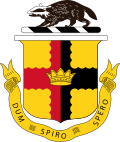 |
維諾拉者 (1917–1946)的曾孫。 | 世襲制 | 1946 | [59] | |
| Muedzul Lail Tan Kiram 蘇丹 | 1986年2月16日 | 克拉姆 |  |
最後在位 Moh. Mahakuttah Kiram(1974-1986)蘇丹之子。[60] | 世襲制 | 1917 | [61] | |
| Yahcub Alimuddin V | 1967年1月3日 | Alimuddin [as 22] | Alimuddin III 蘇丹 (1876–1877)的後裔。 | [62] | ||||
| Rodinood 贾马鲁尔·基拉姆三世 | 1997年2月21日 | 克拉姆 [as 22] |  |
Jamalul Kiram II 蘇丹 (1883–1917)的後裔。 | ||||
| 阮福保恩 | 2017年3月15日 | 阮朝 |  |
保大皇帝 (1926–1945)之子。 | 世襲制 | 1949 | [63] | |
| Hso Khan Pha | 1999年5月26日 | 撣族 | Sao Shwe Thaik 詔法(1927–1962)之子。 | 世襲制 | 1962 | [64] | ||
| Al-Numan VIII El Chemor | 2008 | 伽珊尼德 | Jabala ibn al-Ayham的後裔 | 世襲制 | 638 |
尼泊爾國內的一眾自治王國被聯邦政府於2008年10月7日廢除。自从rajas Gopendra Bahadur Shah 和 Prakash Bikram Shah 在2003年去世以来,Salyan District, 尼泊爾和Jajarkot的王座便保持空位至今[66][67]。
| 國家 | 覬覦者王号 | 自從 | 王室 | 皇家徽章 | 主張 | 繼承性 | 廢除 | 文獻 |
|---|---|---|---|---|---|---|---|---|
| 贾南德拉 | 2008年5月28日[as 23] | 沙阿 [as 24] |  |
最後在位Maharajdhiraja (2001–2008)。 | 世襲制 | 2008 | [68] | |
| 賓諾德·比克拉姆 | 2008年10月7日 | 最後在位拉者(1989–2008)。 | 世襲制[as 25] | [69][70] | ||||
| 普拉喀什 | 2008年10月7日[as 26] | 最後在位拉者(2002–2008)。 | 世襲制[as 25] | [71] | ||||
| Jigme Palbar | 2008年10月7日[as 27] | 比斯塔 [as 28] |  |
最後在位拉者(1964–2008)。 | 世襲制[as 25] | [72] |
| 國家 | 覬覦者王号 | 自從 | 王室 | 皇家徽章 | 主張 | 繼承性 | 廢除 | 文獻 |
|---|---|---|---|---|---|---|---|---|
| 薩利赫·伊本·阿爾-海珊 | 1967年9月17日[as 29] | Al Audhali | 最後在位蘇丹(1928–1967)。 | 世襲制 | 1967 | [73] | ||
| Nasir ibn Aidrus | 1967年11月29日[as 30] | Al Awlaqi |  |
最後在位蘇丹(1947–1967)。 | 世襲制 | [73] | ||
| 阿瓦德·伊本·薩利赫 | 1967年11月29日[as 31] | Al Awlaqi | 最後在位蘇丹(1935–1967)。 | 世襲制 | [73] | |||
| 塔拉勒·本·薩利赫 | 2010年2月15日 | Al Habieli [as 8] |  |
薩利赫·本·阿爾-海珊埃米爾(1935–1967)的繼承者。 | 世襲制 | [74] | ||
| Shafaul ibn Ali Shaif | 1967年8月17日[as 32] | 阿爾-阿米里 |  |
最後在位埃米爾(1954–1967)。 | 世襲制 | [73] | ||
| 納賽爾·本·阿卜杜勒 | 1967年11月29日[as 33] | 阿爾-法德合里 |  |
最後在位蘇丹(1964–1967)。 | 世襲制 | [73] | ||
| Faisal bin Surur | 1967年11月29日[as 34] | Al Haushabi |  |
最後在位蘇丹(1955–1967)。 | 世襲制 | [73] | ||
| 海珊·伊本·阿里 | 1967年10月2日[as 35] | Al Kathiri |  |
最後在位蘇丹(1949–1967)。 | 世襲制 | [73] | ||
| Fadhl VI bin Ali | 1967年8月17日[as 36] | 阿爾-阿布達利 |  |
最後在位蘇丹(1958–1967)。 | 世襲制 | [73] | ||
| Abdullah ibn Ashur | 1967年10月16日[as 37] | Al Mahri |  |
最後在位蘇丹(1966–1967)。 | 世襲制 | [73] | ||
| 迦利布二世 | 1967年9月17日[as 38] | Al Qu'aiti |  |
最後在位蘇丹(1966–1967)。 | 世襲制 | [75] | ||
| 阿里·伊本·穆罕默德 | 1967年8月17日[as 40] | Al Wahidi |  |
最後執政哈基姆(1967)。 | 世襲制 | [73] | ||
| 阿拉維·伊本·薩利赫 | 1967年11月29日[as 41] | 最後在位蘇丹(1955–1967)。 | 世襲制 | [73] | ||||
| 海珊·伊本·阿卜杜勒 | 1967年11月29日[as 42] | 最後在位蘇丹(直至1967年)。 | 世襲制 | [73] | ||||
| Mahmud ibn Aidrus | 1967年8月28日[as 43] | Al Afifi [as 44] |  |
最後在位蘇丹(1954–1967)。 | 世襲制 | [73] | ||
| 穆罕默德·伊本·薩利赫 | 1967年11月29日[as 45] | Harharah [as 44] |  |
最後在位蘇丹(1948–1967)。 | 世襲制 | [73] | ||
| 阿基爾·本·穆罕默德 | 1996年8月6日 | 哈斯木 | 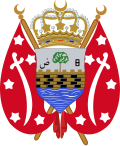 |
穆罕默德·巴德爾國王的長子,最後的國王。 [as 46] | 世襲制 | 1962 | [77] |
| 國家 | 覬覦者王号 | 自從 | 王室 | 皇家徽章 | 主張 | 注释 | 廢除 | 文獻 |
|---|---|---|---|---|---|---|---|---|
| 清邁王國 | Wongsak Na Chiangmai | 1989年 | Thipchak |  |
Kaew Nawarat的孫子 | 世襲制 | 1939 | [78] |
歐洲
| 國家 | 覬覦者王号 | 自從 | 王室 | 皇家徽章 | 主張 | 注釋 | 廢除 | 文獻 |
|---|---|---|---|---|---|---|---|---|
| 莱卡二世 | 2011年11月30日 | 索格 | 
|
最后一任国王的長孫。 | 同时为索格王朝领袖 | 实际上 1939 法律上 1944 |
[79] | |
| 卡尔二世及五世 | 2011年7月4日 | 哈布斯堡-洛林 | 
|
最后一任皇帝之孫。 | 同时为哈布斯堡、洛林及哈布斯堡-洛林王朝领袖 | 1918 | [80] | |
| 洛伦兹一世 | 部分君主主义者认为卡尔二世的婚姻为貴賤通婚,并且卡尔之弟格奥尔格迎娶了路德宗的妻子。因此他们觉得洛伦兹一世为奥匈的王位觊觎者。 | |||||||
| 西美昂二世 | 1946年9月15日 | 萨克森-科堡-哥达 | 
|
末代沙皇 | 前任保加利亚总理 | 1946 | [81] | |
| 恩斯特-約翰 | 1982年2月28日 | 比隆 | 
|
最后一任公爵的后裔 | 比隆家族领袖 | 1795 | [82] | |
| 伊尼戈一世 | 1992年2月1日 | 符腾堡 | 
|
最后一任国王的后裔 | 2012年,伊尼戈一世被立陶宛君主主义者承认为立陶宛王室的合法继承人 | 1918 | [83][84] | |
| 菲利普·罗宾 | 2013年5月23日 | 黑森-卡塞尔 | 
|
最后一任国王的后裔 | 两位推定继承人的其中一位 | 1918 | [85] | |
| 海因里希二世 | 两位推定继承人的其中一位 | |||||||
(詹姆斯主义) |
弗朗西斯二世 | 1996年7月8日 | 維特爾斯巴赫 | 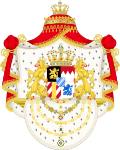
|
查理一世的后裔 | 詹姆斯党的唯一继承人,并未婚 | 1688 | [83][84] |
| 西蒙·黑斯廷斯 | 2012年6月30日 | 坎贝尔 | 
|
乔治·金雀花的后裔 | 有可能为英国真正的君主。 | 1485 | [83][84] | |
| 卡罗琳·查尔德-维利耶 | 1998年8月9日 | 格伦威尔 | 
|
玛丽·都铎的后裔 | 1603 | [83][84] | ||
| 特蕾莎·费尔曼-格伦维尔 | 2012年9月30日 | 维利尔斯 | 
|
玛丽·都铎的后裔 | 1603 | [83][84] | ||
(波旁派) |
路易二十 | 1989年1月30日 | 波旁-安茹 | 
|
最后一位正统派国王的亲戚 | 实际上,所有费利佩五世的后裔是没有法国王位继承权的 | 1830 | [86][87] |
| 查理十三世 | 2008年12月21日 | 波旁-南多夫 | 
|
不明,可能不是波旁王朝成员。伪路易十七的后裔。 | [88][87] | |||
| 巴尔达萨·拿破仑四世 | 1971年 | 波旁-博帕尔 | 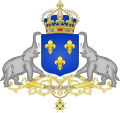
|
不明,可能不是波旁王朝成员。自称为波旁公爵夏尔三世的后裔 | [89] | |||
(奧爾良派) |
让四世 | 2019年1月21日 | 奥尔良 | 
|
最后一任国王的后裔 | 奥尔良派及少数正统派所支持的王位觊觎者 | 1848 | [90][91] |
(波拿巴派) |
拿破仑七世 | 1997年5月3日 | 拿破仑-波拿巴 | 
|
拿破仑三世的亲戚 | 被父亲拿破仑六世略过,直接由其子继承。 | 1870 | [92][93] |
| 拿破仑八世 | 由祖父遗嘱亲自指定的继承人。 | |||||||
| 玛利亚一世 | 1992年4月21日 | 罗曼诺夫 | 
|
亚历山大二世的后裔 | 三个觊觎者中的其中一个 | 1917 | [94][95] | |
| 尼古拉三世 | 2013年6月1日 | 
|
亚历山大二世的后裔 | 三个觊觎者中的其中一个 | [94][95] | |||
| 阿列克谢三世 | 2021年11月28日 | 
|
尼古拉一世的后裔 | 三个觊觎者中的其中一个 | [94][95] | |||
| 腓特烈十世 | 2024年1月14日 | 格呂克斯堡 | 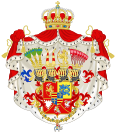
|
最后一任国王的后代。 | 同时为丹麥國王 | 1944 | ||
| 保羅二世 | 2023年1月10日 | 格呂克斯堡 | 
|
康斯坦丁二世国王之子。 | 同时为丹麦王子 | 1973 | ||
| 格奧爾格·腓特烈一世 | 1994年9月25日 | 霍亨索倫 | 
|
威廉二世的后裔 | 同时具備英国王位的第212顺位继承權。 | 1918 | [96] | |
| 亞歷山大二世 | 1970年11月3日 | 卡拉喬傑維奇 | 
|
彼得二世的獨子 | 1945年 |
| 國家 | 覬覦者王号 | 自從 | 王室 | 皇家徽章 | 主張 | 繼承性 | 廢除 | 文獻 |
|---|---|---|---|---|---|---|---|---|
| 埃莫恩王子 | 2021年6月1日 | 薩伏依王朝 |  |
维托里奥·埃马努埃莱二世的玄孫 | 世襲制 | 1946 | [97][98] | |
| 埃曼努埃莱·菲利伯托 | 2024年2月3日 | 翁貝托二世之孫 | ||||||
| 統一前 | ||||||||
| 洛倫茲親王 | 1996年2月7日 | 埃斯特家族[eu 1] |  |
Great-grandnephew of Franz Ferdinand, adopted heir of Duke Francis V (1846–1859). | 世襲制 | 1859 | [99] | |
| 卡洛斯 (帕爾馬) | 2010年8月18日 | 波旁-帕爾馬家族[eu 2] |  |
Great-grandson of Duke Robert I (1854–1859). Also one of the contested heirs to the Carlist succession.[100] |
世襲制 | 1859 | [101][102] | |
| Sigismondo | 1993年6月18日 | 哈布斯堡-洛林王朝 |  |
Great-great-grandson of Grand Duke Ferdinand IV (1859). | 世襲制 | 1859 | [103] | |
| 佩德羅 | 2015年10月5日 | 波旁-兩西西里王朝[eu 3] |  |
Great-great-great-grandson of King Ferdinand II (1830–1859). | 世襲制 | 1861 | ||
| 卡洛 | 2008年3月20日 | Great-great-grandson of King Ferdinand II (1830–1859). | ||||||
太平洋
| 國家 | 覬覦者王号 | 自從 | 王室 | 皇家徽章 | 主張 | 注释 | 廢除 | 文獻 |
|---|---|---|---|---|---|---|---|---|
| Tem Tokataake[oc 1] |  |
Tem Binoka (1878–1891)的後裔。 | 世襲制 | 1911 | [106][107] | |||
| 羅斯五世 | 1978年9月1日[oc 3] | Clunies-Ross |  |
最後在位國王 (1944–1978)。 | 世襲制 | 1978 | [109] | |
| Valentino Riroroko Tuki | 2011年7月 |  |
Atamu Tekena 國王 (1883–1889)的後裔。 | 世襲制 | 1888 | [111] | ||
| 艾碧該·卡拉卡瓦 | 1969年5月20日 | 卡拉卡瓦[oc 4] | 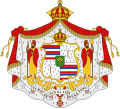 |
大衛·卡拉卡瓦的後裔,利留卡拉尼女王 (1891–1895)的繼承者。 | 世襲制 | 1895 | [113] | |
| 昆汀·卡拉卡瓦 | 1997年7月29日 | [114] | ||||||
| Noa Kalokuokamaile[oc 5] | 1988年9月19日 | 拉阿努伊[oc 6] |  |
Kalokuokamaile 的後裔,卡美哈梅哈一世國王 (1795–1819)同父異母的兄弟。 | 世襲制 | [116] | ||
| 利奥波德·波瑪爾[oc 7] | 波瑪爾 |  |
波瑪爾四世女王(1877–1880)的後裔。 | 世襲制 | 1880 | [119] | ||
| 儒安维尔·波瑪爾[oc 8] | 2009年5月28日 | |||||||
| Tauatomo Mairau[oc 9] | 2005年3月17日 | [120] |
參見
註釋
參考文獻
延伸閱讀
Wikiwand - on
Seamless Wikipedia browsing. On steroids.
